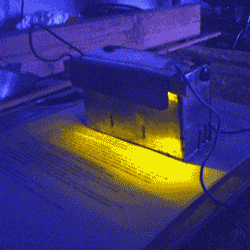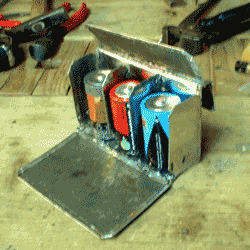Improving conditions for Education

Progress within poverty depends on improving conditions for education for 1 billion students world wide. Education available for this age group would be more effective when additional conditions for learning are improved. Inproved education has also the supplementary conditions for learning to consider. The first and last hours of the long tropical night are very suitalbel for doing home work, is only proper illumination can be provided.
- Poverty reduces the chance of young people to study at home.
Cramped interior space used by many and insufficient interior lighting are negative factors to be overcome. This is dramatically illustrated by students in Bangui, the capital of the Central African Republic. Even when it is raining, students gather under street lights to study, protecting their books with plastic.
- To study, illumination should be of good enough quality. Housing
conditions normally do not offer this. Illumination from overhead floricent tubes is too weak, light from gas-lamps may be strong enough, but radiates heat, crates sharp shadows and attracts insects. The commonly used torches could be somehow effective, if the cost for the short lasting batteries would not be prohibitive.
- Illumination for reading and writing has to offer conflicting properties:
available for each student, almost free of cost, easy to move around, not attracting insects. A mobile reading light gives students a chance to make best use of space around. A reading light should be almost free of cost, yet be very effective and practical.
- As such a reading lamp is immediately needed by a billion students,
a way of providing it in such big quantities has to be designed. Therefore is should be easy to make it with the help of a construction manual relying only on local resources. The design of the reading light has to fulfill above functional conditions, a method that it can be locally made, both integrated in a campaign to spread the news among youngsters that it concerns.
How does it work
a proper reading light, called the NightReader. Compared to the heat of the day, these hours have the charm of relaxing coolness, specially when sitting outside. These hour are ideal for study, it is easier to concentrate one's thought, read and write. Moreover, outdoor space is the only space available for students to escape the hindrance of cramped housing conditions. Outdoor space is only useful if study resources can be illuminated, while not attracting insects. It is not possible to write and read while insets crawl over the lamp, the book and the paper to write on. When the light source is shielded off for the readers eyes, that are accommodated to the dark, little light is enough when shining only on the part of the page one is reading or is writing on.
or paper to be read. The LED's only illuminates a few lines of text, not attracting insects. LED's are the ideal light source for this purpose. LED's are-high tech electronic components that are constructed to emit a small amount of light, that is just enough to read with. LED's consume little current, only 10 milli Amperes, 50 times less than a bulb for an electric torch. Their construction is robust, its functional life is practical unlimited, if only the voltage over its contacts does not exceed a certain maximum depending on the type of LED's (2 Volts with the NightReader). Last but not least, the LED's cost only 20 Euro cent per piece when bought in larger quantities. The electric current that still can be drawn from batteries, too exhausted for use in a torch or radio can be enough to make the LED's light up. Many of such nearly exhausted batteries are available, also in conditions of poverty. The design for the NightReader uses this property to get free energy to power the LED-lights. The LED's are attached to a box, that can house only three batteries, thereby limiting the maximum voltage derived from the batteries. The LED's will emit light, whether these batteries are almost exhausted or brand new, thanks to the design of a simple electric circuit. The battery box will take any of the three common sizes of batteries, pen-light (AA), half and full. Being nonspecific on size, the chance of getting a set of batteries that work is the best.
its user or by people around, uses only local scrap material, such as tin or roof sheet for its housing, electric wire from wrecked cars, foam plastic from an old mattress to fill up the difference in space when different sizes of batteries are used. Regarding cost, only the LED's have to be bought. For the construction of the NightReader no special tools are needed, but with a few simple templates and folding guides construction becomes very easy and takes little time. Technical specifications, suggestions for circuits and partsTarget for the electronic cirquit is cheap and robust and long lasting (>5jrs). Integration of parts not as a start, but to be considered for future assembly. Charging during day time (not direct sunlight) which should deliver a capacity for 4 hours use at night.
Schools adopt schools to provide NightReaders to all studentsPeer to peer projects between students in rich and poor countries can arouse interest and stimulate the construction and use of the NightReader. Studying during the evening at home normal in developed countries and next to impossible in poor countries? No need to accept this, rich schools may take the initiative to change this. And to change this is within their reach, creating a NightReader peer to peer project. For this a school and its students in a rich country adopt a school and its students in a poor country. Students in rich countries have enough experience on Internet to find and contact a school in a (poor) country of their liking. Then the students find out what is the real situation: is there a need for the NightReader? Does the other school has interest in such a project? If yes, what precise are the local conditions? So the rich school students get to know what is the reality for their peers in that far away country. Together with their teachers they make a plan. It is impractical to make all the NightReaders and send them. Better is it to provide teaching materials for that other school.
Light up the World Foundation: http://www.lutw.org
http://ask.slashdot.org/article.pl?sid=03/05/05/2244211&mode=thread&t...
http://www.id21.org/society/s1besd1g1.html
http://www.circuitsonline.net/circuits/view.php?id=104
Their DIY Solar technique allows the construction of low cost pv panels to power radios, torches, etc. It can be used both by NGOs and those starting a small business. This is an example how it could work with the NightReader. http://www.biodesign.org.uk/ http://www.oneworld.org/wacc/publications/action_archive/action235/so... http://www.biodesign.org.uk/page.php?domain_name=biodesign.org.uk&vie...
How they work, how to manage colours, why some LED-colors are cheap and others expensive. Many links to other sources of info on application of LED's. http://www.idfuel.com/index.php?p=178&more=1#more178
Home-based workers: neglected by policy-makers and labour organisers? Home workers are a flexible and cheap labour force and almost 80 percent are female. They are 'invisible' in the regular labour market and their interests and priorities are not at the forefront of political or labour organisations. http://www.id21.org/society/s7crp1g1.html
|